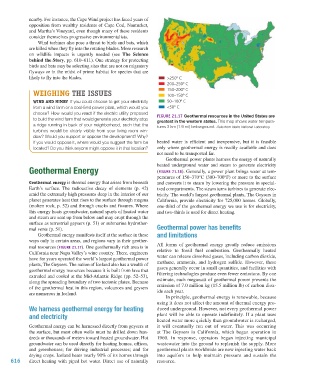Page 617 - Environment: The Science Behind the Stories
P. 617
nearby. For instance, the Cape Wind project has faced years of
opposition from wealthy residents of Cape Cod, Nantucket,
and Martha’s Vineyard, even though many of these residents
consider themselves progressive environmentalists.
Wind turbines also pose a threat to birds and bats, which
are killed when they fly into the rotating blades. More research
on wildlife impacts is urgently needed (see The Science
behind the Story, pp. 610–611). One strategy for protecting
birds and bats may be selecting sites that are not on migratory
flyways or in the midst of prime habitat for species that are
likely to fly into the blades. >250º C
200–250º C
WEIGHING tHE IssUEs 150–200º C
100–150º C
WINd ANd NIMby If you could choose to get your electricity 50–100º C
from a wind farm or a coal-fired power plant, which would you <50º C
choose? How would you react if the electric utility proposed Figure 21.17 Geothermal resources in the United States are
to build the wind farm that would generate your electricity atop greatest in the western states. This map shows water tempera-
a ridge running in back of your neighborhood, such that the tures 3 km (1.9 mi) belowground. Data from Idaho National Laboratory.
turbines would be clearly visible from your living room win-
dow? Would you support or oppose the development? Why?
If you would oppose it, where would you suggest the farm be heated water is efficient and inexpensive, but it is feasible
located? Do you think anyone might oppose it in that location? only where geothermal energy is readily available and does
not need to be transported far.
Geothermal power plants harness the energy of naturally
heated underground water and steam to generate electricity
Geothermal Energy (Figure 21.18). Generally, a power plant brings water at tem-
peratures of 150–370°C (300–700°F) or more to the surface
Geothermal energy is thermal energy that arises from beneath and converts it to steam by lowering the pressure in special-
Earth’s surface. The radioactive decay of elements (p. 42) ized compartments. The steam turns turbines to generate elec-
amid the extremely high pressures deep in the interior of our tricity. The world’s largest geothermal plants, The Geysers in
planet generates heat that rises to the surface through magma California, provide electricity for 725,000 homes. Globally,
(molten rock, p. 52) and through cracks and fissures. Where one-third of the geothermal energy we use is for electricity,
this energy heats groundwater, natural spurts of heated water and two-thirds is used for direct heating.
and steam are sent up from below and may erupt through the
surface as terrestrial geysers (p. 51) or submarine hydrother-
mal vents (p. 51). Geothermal power has benefits
Geothermal energy manifests itself at the surface in these and limitations
ways only in certain areas, and regions vary in their geother-
mal resources (Figure 21.17). One geothermally rich area is in All forms of geothermal energy greatly reduce emissions
California near Napa Valley’s wine country. There, engineers relative to fossil fuel combustion. Geothermally heated
have for years operated the world’s largest geothermal power water can release dissolved gases, including carbon dioxide,
plants, The Geysers. The nation of Iceland also has a wealth of methane, ammonia, and hydrogen sulfide. However, these
geothermal energy resources because it is built from lava that gases generally occur in small quantities, and facilities with
extruded and cooled at the Mid-Atlantic Ridge (pp. 52–53), filtering technologies produce even fewer emissions. By one
along the spreading boundary of two tectonic plates. Because estimate, each megawatt of geothermal power prevents the
of the geothermal heat in this region, volcanoes and geysers emission of 7.0 million kg (15.5 million lb) of carbon diox-
are numerous in Iceland. ide each year.
In principle, geothermal energy is renewable, because
using it does not affect the amount of thermal energy pro-
We harness geothermal energy for heating duced underground. However, not every geothermal power
and electricity plant will be able to operate indefinitely. If a plant uses
heated water more quickly than groundwater is recharged,
Geothermal energy can be harnessed directly from geysers at it will eventually run out of water. This was occurring
the surface, but most often wells must be drilled down hun- at The Geysers in California, which began operation in
dreds or thousands of meters toward heated groundwater. Hot 1960. In response, operators began injecting municipal
groundwater can be used directly for heating homes, offices, wastewater into the ground to replenish the supply. More
and greenhouses; for driving industrial processes; and for geothermal plants worldwide are now injecting water back
drying crops. Iceland heats nearly 90% of its homes through into aquifers to help maintain pressure and sustain the
616 direct heating with piped hot water. Direct use of naturally resource.
M21_WITH7428_05_SE_C21.indd 616 12/12/14 4:29 PM

